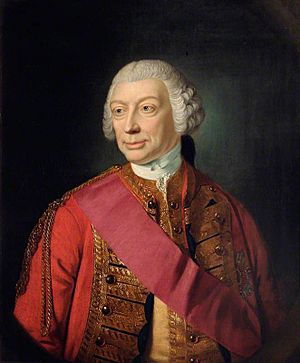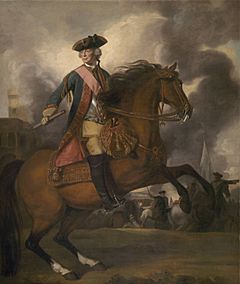John Ligonier, 1st Earl Ligonier facts for kids
Quick facts for kids
John, 1st Earl Ligonier
|
|
|---|---|

Field Marshall John Ligonier, 1st Earl Ligonier
|
|
| Master-General of the Ordnance | |
| In office 1759–1763 |
|
| Commander-in-Chief of the Forces | |
| In office 1757–1759 |
|
| Military Governor of Plymouth | |
| In office 1752–1759 |
|
| Governor of Guernsey | |
| In office 1750–1752 |
|
| Member of Parliament for Bath |
|
| In office 1748–1763 |
|
| Personal details | |
| Born | 7 November 1680 Castres, France |
| Died | 28 April 1770 (aged 89) North Audley St, London |
| Resting place | St Andrews, Cobham, Surrey |
| Relations | Francis Ligonier (1693–1746) |
| Awards | Knight of the Bath |
| Military service | |
| Allegiance | |
| Years of service | 1702–1759 |
| Rank | Field marshal |
| Unit | Colonel, 7th Dragoon Guards 1720–1749 Grenadier Guards 1757–1770 |
| Battles/wars | |
Field Marshal John Ligonier, 1st Earl Ligonier (born 7 November 1680 – died 28 April 1770) was a brave and important military leader in Britain. He was born in Castres, Southern France, with the name Jean Louis de Ligonier. His family were Huguenots, which means they were French Protestants who had to leave France because of their religion.
John Ligonier had a very long and successful career in the British army. He became the Commander-in-Chief in 1757, which meant he was in charge of the entire British army. During the Seven Years' War, he also served as the Master-General of the Ordnance, acting like a Minister of War. He stopped his active military duties in 1763 and passed away in London in 1770.
Contents
A Soldier's Life: John Ligonier's Military Career
John Ligonier's family moved to England in 1697. He went to school in France and Switzerland. In 1702, he joined the army in Flanders, a region in Europe.
Early Battles and Bravery
Ligonier showed great courage early in his career. He fought bravely in the War of the Spanish Succession. In October 1702, he was one of the first soldiers to break through the defenses during the siege of Liège.
He became a captain in 1703. He then led his company in many important battles:
- Schellenberg (July 1704)
- Blenheim (August 1704)
- Ramillies (May 1706)
- Oudenarde (July 1708)
- Malplaquet (September 1709)
At the Battle of Malplaquet, he was incredibly lucky. Even though twenty-three bullets went through his clothes, he wasn't hurt at all! In 1712, he became the governor of Fort St. Philip in Menorca.
Leading Troops and Earning Honors
During the War of the Quadruple Alliance in 1719, Ligonier was a key leader in the Vigo expedition. He led the soldiers who stormed the town of Pontevedra.

Two years later, he became a colonel of a famous cavalry unit called the "Black Horse." He continued to rise through the ranks, becoming a brigadier general in 1735 and a major general in 1739.
In 1742, he was promoted to lieutenant general. King George II personally made him a Knight of the Bath on the battlefield after the Battle of Dettingen in June 1743. This was a very special honor.
At the Battle of Fontenoy in May 1745, Ligonier commanded the British and German infantry.
Defending Britain and Daring Charges
During the Jacobite rising of 1745, Ligonier was called back to Britain to lead the army in the English Midlands. In November 1745, he led troops to stop the rebels in Lancashire.
He was promoted to general of horse in 1746. He then led the British forces in the Low Countries. He was at the Battle of Rocoux in October 1746.
In July 1747, at the Battle of Lauffeld, Ligonier led a powerful charge of the British cavalry. He attacked with such force that he broke through the entire French cavalry line! During this charge, his horse was killed, and he was captured by King Louis XV. However, he was quickly exchanged and set free within a few days.
An official report praised his actions, saying:
it is impossible to commend too much the conduct of the generals both horse and foot. Sir John Legonier, who charged at the head of the British dragoons with that skill and spirit that he has shown on so many occasions, and in which he was so well seconded...
After these battles, he became a Member of Parliament for Bath in 1748. He also became the colonel of the 2nd Dragoon Guards in 1749. From 1748 to 1770, he was the governor of the French Hospital, which helped French Protestants in England.
In 1750, he was made Governor of Guernsey, and in 1753, he became the colonel of the Royal Horse Guards.
Leadership During the Seven Years' War
In September 1757, John Ligonier was given a very important job: Commander-in-Chief of the Forces. This meant he was the top military leader in Britain. He worked closely with the government to plan strategies for the Seven Years' War.
On 3 December 1757, he was promoted to field marshal, the highest rank in the British army. He also became the Colonel of the 1st Foot Guards. A few days later, he was given a special title, becoming Viscount Ligonier of Enniskillen.
In 1759, there was a fear that France might try to invade Britain. Ligonier was put in charge of the British forces that would defend the country, though the invasion never happened. He stepped down as Commander-in-Chief in 1759 and became the Master-General of the Ordnance. This role involved managing military supplies and weapons.
For his great service, he received more honors. In 1762, he became Viscount Ligonier of Clonmell, and in 1763, he became a Baron. Finally, in 1766, he was made an Earl in the British peerage.
Later Years and Legacy
John Ligonier spent his later years at Cobham Park in Cobham, Surrey, a place he bought around 1750. He never married. He passed away on 28 April 1770 and was buried in Cobham Church. There is a monument honoring him in Westminster Abbey, a famous church in London.
When he died, his highest title, the earldom, ended. However, his other title, the Irish viscountcy, and Cobham Park went to his nephew, Edward. John Ligonier's younger brother, Francis, was also a respected soldier.
Sources


